
How to Care for Rose Bushes - A Guide for Beautiful Roses
Published: 14/03/2024 | Updated: 14/03/2024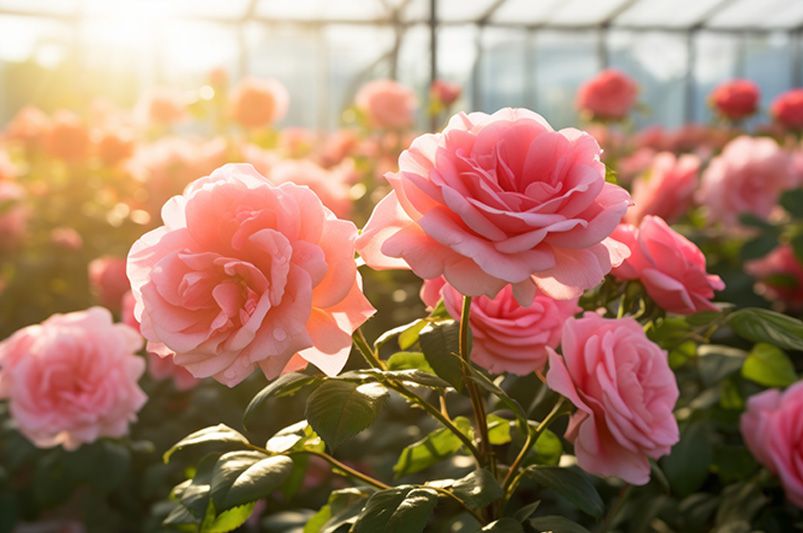
The rose is a well-loved flower over the globe. There are more than a hundred different species of this perennial shrub, most of which are found in North America. Roses are highly regarded due to their attractive appearance and, in some cases, aroma. Rose flowers can be quite little and compact, or they can be very huge and voluminous. Almost every type of rose has thorns.


The three most common rose varieties are shrub roses, climbers, and ramblers. A rambler can be used as groundcover and to give a garden a more natural appearance, while a shrub is more suited for gardens and borders. Climbers are great for hiding walls or adding color to outdoor structures.
Due to their frequent need for pruning and other maintenance, roses are commonly seen as challenging plants to grow and care for. Although this may have been the case in the past, roses have been developed and nurtured to become less of a hassle for gardeners.
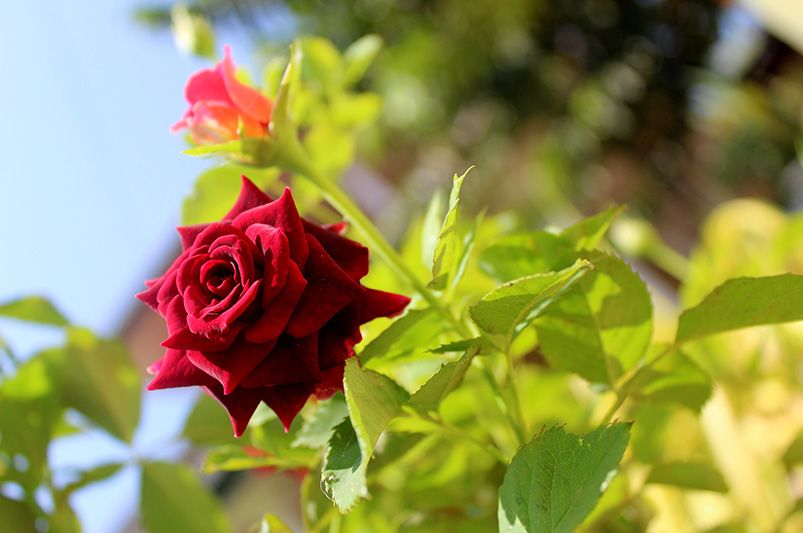
About Rose Bushes
The fragrant blooms of the rose bush (Rosa spp. ), a shrub type, make this plant so popular. A few of the rose bushes are climbers, while the others either trail or stand erect. They have sharp thorns embedded in their woody stems. The passion of rose growers to achieve flawless blooms every year may contribute to the plant's notorious fussiness. Roses are surprisingly resilient plants that may survive with minimal attention.
If you plant roses in the spring and provide them with plenty of water and fertilizer, they will blossom profusely all through the summer. This in-depth rose garden manual will teach you everything you need to know about rose bush cultivation and maintenance.
-
Classic Rose Bushes: Roses that existed before 1867 are considered heirloom roses or old-fashioned roses. The roses depicted in the works of the classic masters are always lush and fragrant. There are many options for both hot and mild settings because of the hundreds of antique rose varietals available.
-
Hybrid Modern Rose Bushes: Flowers bred for color, form, size, and smell that were introduced after 1867 are hardy, long-blooming, highly hardy, and disease-resistant. Hybrid tea roses, which feature a single enormous bloom at the end of a long cutting stem, are among the most sought-after varieties.
-
Wild Roses: Roses that have been growing in the wild for thousands of years are considered species. These once-wild roses now thrive in urban gardens, where they bloom in the early summer. Single flowers are typical for rose species.
How to Care for Rose Bushes
Follow the planting instructions for your variety of roses and use deep holes partially filled with lots of modified soil, for drainage. The roots can be stretched out across the cone shape created at ground level at the bottom of the planting hole, as suggested by some. In this way, the roots are encouraged to grow downward vertically.
When caring for established plants, start the new growing season by removing winter covering material, then cut and feed at the right time according to local weather patterns. Sprays can be applied now to prevent diseases and pests from getting a head start. Deadheading is the practice of removing spent flowers from perennials so that the plants can use that energy to grow and flower again later in the season.
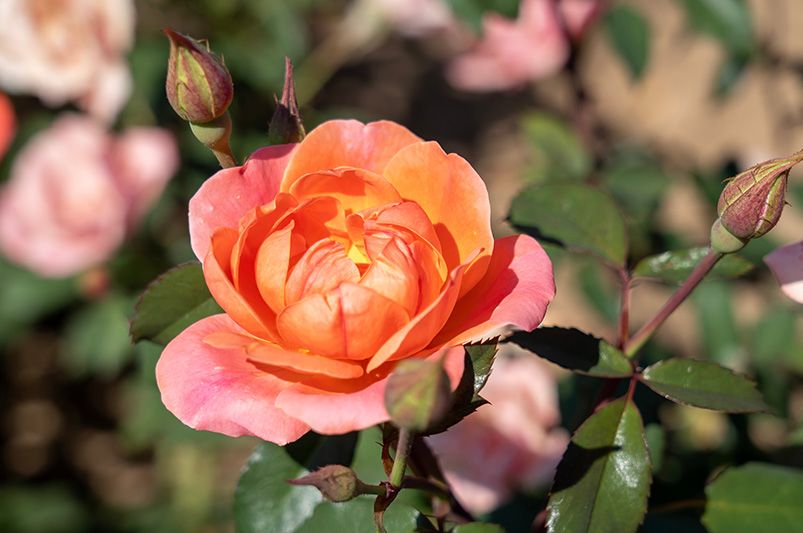
Sunlight
Even though roses like daily sun exposure of at least six hours, the timing of that exposure is critical. Two things make the morning sun better than the afternoon sun for getting your daily dose of vitamin D:
-
Rose leaves thrive in arid conditions. The lower the risk of disease, the faster the dew from the night may be burnt off the leaves.
-
The heat of the afternoon sun might be unbearable. Shade in the afternoon is beneficial for roses.
Humidity & Temperature
Roses can withstand occasional weather extremes, but they do best in a range of 60–70 degrees Fahrenheit with 60%–70% humidity.
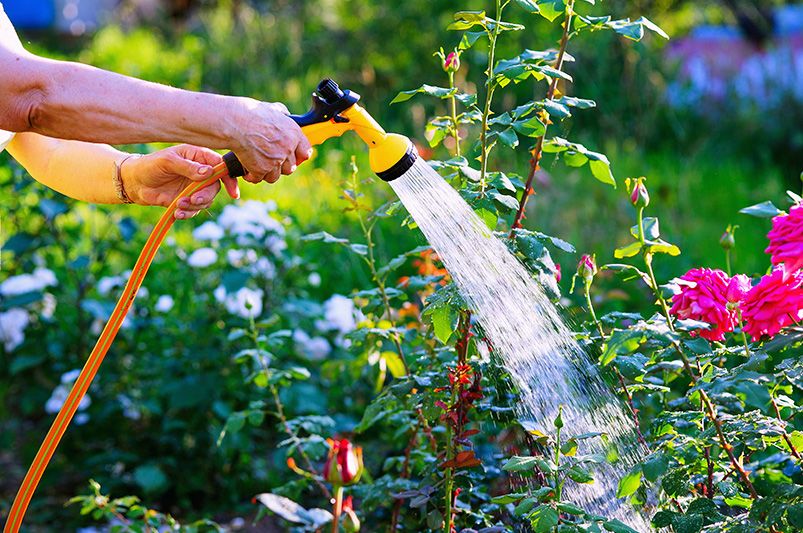
Watering
Roses need to be watered at least twice a week, and ideally more often. It's preferable to water thoroughly twice weekly rather than shallowly more often.
Late-night watering encourages powdery mildew, a common rose plant disease. Putting off watering until the evening prevents the sun from drying things out during the day. As a result, condensation and overnight humidity foster the growth of powdery mildew.
Avoid overhead watering of roses for the same reason. Wet leaves are an open invitation for powdery mildew to invade miniature roses. Instead, sprinkle it on the ground.
Soil
Loamy, well-drained soil with a pH between 6.5 and 6.8 is ideal for growing roses. Do not neglect to improve drainage by introducing peat moss while amending the soil. It doesn't matter what time of year it is, always cover the soil surrounding rose bushes with 2 or 3 inches of mulch.
Fertilizer
If you're just starting, it's recommended that you use a 10-10-10 rose fertilizer on your roses once a month. Initiate feeding in the spring, when growth is at its peak and pruning is being done.
Pruning
For novice gardeners, rose bush pruning might be one of the most challenging tasks. Bypass pruners, as opposed to anvil pruners, which can crush the stems, should be used. Here are some suggestions for pruning rose bush care that you can adapt to your local climate:
Some varieties of roses don't benefit from pruning, but the vast majority do, especially if done in early spring before the leaf buds open. When to prune roses, exactly, depends on where you live.
Roses can be pruned in January if you live in a mild climate with mild winters and little chance of freezing. Even though pruning roses isn't always necessary in regions with mild winters, it's still a good idea to clean up (by removing dead or diseased wood) and thin plants as necessary.
Some rose growers in warmer climes choose to completely defoliate their rose plants each spring, allowing the plants to rest for a while and getting rid of any diseased or insect-infested leaves. This artificial rest prepares the plants for the next growing season.
If you try this method, be sure to properly dispose of (not compost) all of the fallen leaves to avoid spreading any potential pests or diseases. Wait until April, or until the leaf buds are fully expanded but not yet open, if you live in a cold area. Keep an eye out for the vivid yellow forsythia flowers that bloom at this time of year.
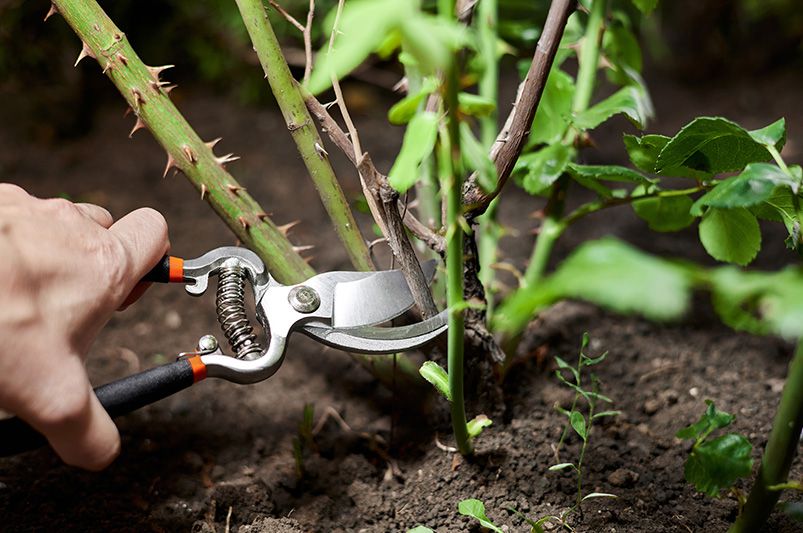
Overwintering
Roses may need extra care over the winter if you live in a colder region. They work well as both foundation plantings and windbreaks for winter protection when placed near a home's base.
When all else fails, you can try the "Minnesota Tip" for winterizing your plant, which entails laying the plant's canes in a trench dug into the ground and covering the entire thing with soil, mulch, or a pile of leaves.
Most roses need to be tended to and prepared for the growing and blooming season in the spring.
Pest & Diseases
Roses are rather hardy plants that thrive with minimal issues from pests and illnesses when given the right water and nutrients (when planted in temperate areas). Here are just a few examples of potential issues with landscape roses:
-
Insect Pests: Try growing garlic alongside your roses to deter pest insects. You may also create a homemade "insecticidal soap" by adding some dishwashing soap to the water when you water your roses once a week (of course, you can also purchase actual insecticidal soaps).
Horticultural oil is effective at killing insect eggs and larvae, and it is best applied in the spring.
-
Powdery Mildew: If rose bushes are not given enough room to flourish, they are more likely to develop powdery mildew. The best defense is a healthy dose of space between your rose bushes. When selecting rose bushes, be sure to pay attention to the recommended plant spacing for each variety. As was already indicated, it's best to water in the morning rather than at night.
-
Black Spots & Other Fungai: Another issue that arises from crowded roses and excess moisture is a fungus. Fungus spores (such as black spots) that grew in the fall and survived the winter can be eliminated by spraying the plants with lime sulfur in the spring.
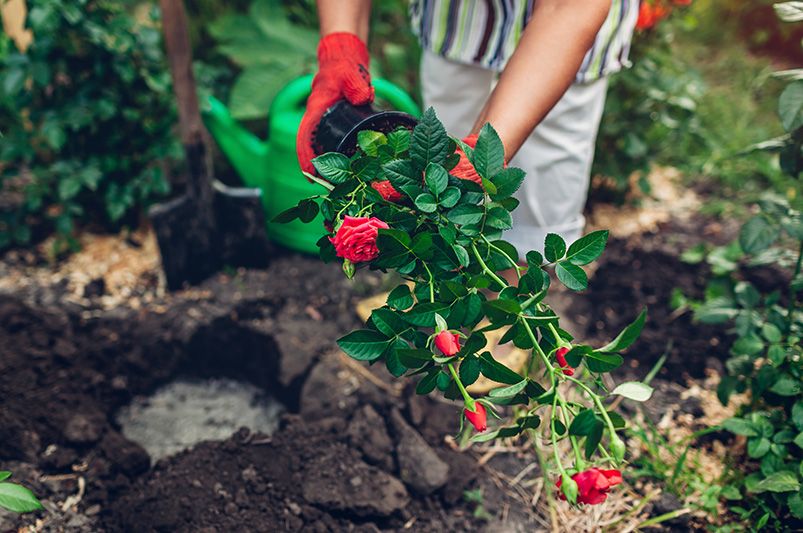
Everything on Planting Roses
Best Time to Plant Roses
Keep the date of planting in mind when ordering bare-root roses online. When you order bare-root roses, plant them as soon as they come.
Roses in North America are typically delivered in the early spring when the plants are still dormant and haven't yet begun to leaf out. They'll show up looking like a bunch of sticks. They are not dead, but rather hibernating. Keep them in a cold, dark area until you're ready to plant them, and make sure the packing paper is still damp.
-
Bare-root roses should be planted as soon as the soil is workable in the spring in cooler climates.
-
Bare-root roses can be planted in the early spring or late fall in warmer climates, when the plant is dormant, but the soil is still warm.
The best time to plant roses purchased in containers is in late spring. It's best to water them frequently, especially in the summer, but you can plant them whenever you like during the growing season.
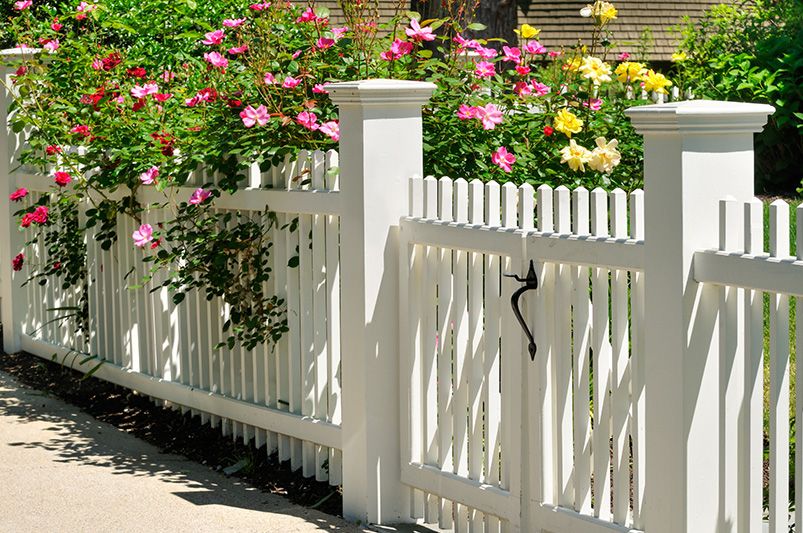
Where to Plant Roses
Roses require at least six hours of sunlight per day to thrive, so plant them accordingly. Particularly beneficial humidity roses are the morning light, which dries the leaves and so aids in disease prevention. Although roses growing in dappled light may not suddenly perish, their flower quality and winter hardiness suffer.
Keep in mind that the light varies with the seasons due to the sun's varying angle. If you live in the northern half of the United States, pick a spot that gets plenty of sunlight all through the hours of sun year. The more sunshine a plant receives, the more blossoms it will produce. Pick locations in the southern portion of the United States that get some afternoon shade. This shield flowers from the hot sun, extending their life and beauty.
Growing roses near the house's foundation is a good idea in colder climates. This shields plants from the cold weather to some extent. Sunlit walkways are another viable option.
Don't cram in too many flowers if that's your aim. Powdery mildew and downy mildew are two fungal illnesses that can be avoided with well-ventilated spaces.
Roses require soil that drains properly but still retains some moisture for the plant's roots to use. Not providing enough drainage is a serious oversight. Water and cold are terrible for roses.
Roses thrive in sandy, loamy soil with some loose particles. Roots might rot if exposed to too much clay. Loose, loamy soil is ideal, but if you don't have that, you may need to add some amendments.
Roses thrive in soil with a pH of between 5.5 and 7.0. The ideal pH for most home gardens is 6.5.
-
A precise soil test will provide the present pH level. Soil that is too acidic can be addressed by mixing in ground limestone, whereas soil that is too alkaline can be treated by mixing in ground sulfur. Get educated on the topic of soil amendments.
Planting
Protect your hands from thorns by donning a robust pair of gloves. Prepare for planting by having water on hand in the form of a hose or bucket.
Before planting your bare-root roses, soak them in a basin of water for at least 8 hours. Reduce each cane to three to five buds. You shouldn't use a cane that's any thinner than a pencil.
Roses growing in containers need to have their roots loosened before being planted. For most rose varieties, a planting hole of 15–18 inches in width is recommended. Fill the hole with lots of organic matter, such as compost or aged manure. After planting, water heavily.
While the rose is adjusting to its new environment, mound up some sand or loose soil around the canes to keep it safe. Roses benefit from calcium and iron; therefore, some old-timers suggest adding a 4-inch square of gypsum wallboard and a 16-penny nail to the hole.
If you want to ever grow roses on more than one rose bush, give each one plenty of room. Plant roses at a distance equal to around two-thirds of their mature height. In contrast to small roses, old-fashioned garden roses require greater area.
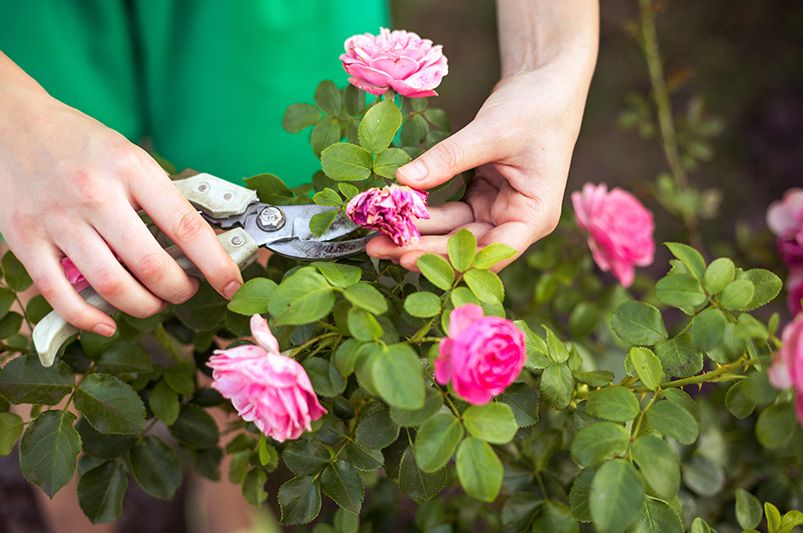
Getting Roses to Bloom
Preparing roses for flowering involves making sure they never go hungry by providing them with enough water and fertilizer. Roses that have been well cared for are far more likely to bloom profusely all season long.
Removing spent rose blossoms (known as deadheading) can stimulate new rose blooms too.
Certain types of roses may bloom continuously throughout the summer. Among these are floribunda roses, grandiflora roses, climbing roses, shrub roses, and hybrid tea roses.
Plants to Pair with Rose Bushes
Don't forget to think about which plants might complement your roses. To draw attention to the roses' lush green leaves and flowers, plant some pretty purple catmint (Nepeta) among them. This works especially well with pink roses. Tall-growing pinks (Dianthus), lavender (Lavandula), and lady's mantle (Alchemilla) all provide these benefits, and lavender also aids in weed suppression. If you want to keep your roses disease-free, space them off from other plants by at least a foot.
If you have a problem with pests, you might choose companion plants that will help keep them away.
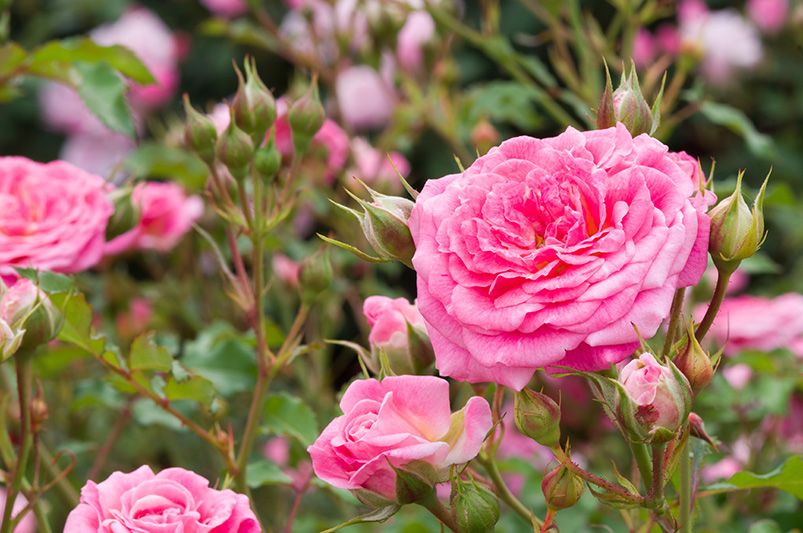
Rose Varieties
-
Easy Elegance Roses': Roses of the 'Easy Elegance' variety are prized for their beauty and low maintenance requirements. These roses have been selected for their hardiness and resistance to disease. All these plants require to thrive is some morning sun and a little watering now and again. The 'Yellow Brick' or 'Easy Elegance' rose is known for its lovely, traditional scent.
-
Knock Out Roses: Roses from the 'Knock Out' series are available in a wide range of hues, and their blooms are known to linger all summer and into the fall. The roses look great when planted in a dense row along a fence because they can be purchased as a medium-sized shrub and are nearly as wide as they are tall. They are also attractive when scattered among perennials or bushes. Knock Out has a very subtle floral aroma.
-
Drift Roses: The Drift rose is a very recent introduction. Tiny roses bloom on these shawls. Since 'Drift' roses are both thick and wide, they are also useful as groundcover roses. When combined with herbs, annuals, and perennials, these roses create a beautiful flowerbed.
Get to Planting!


